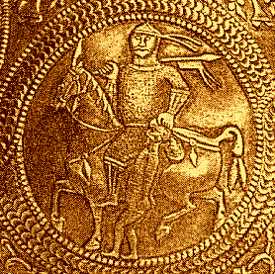Khirbet Qeiyafa ostracon, Elah Valley (near Beit Shemesh), 11th century BCE
Solomon's Temple, Jerusalem, 957 BCE
 Archaeologists have uncovered many remains of synagogues from over two thousand years ago, including several that were in use before the destruction of the Temple in Jerusalem. Synagogues securely dated to before the destruction of the Temple in Jerusalem include the Migdal Synagogue, the ancient synagogue at Gamla, the synagogue of Capernaum, the Herodium synagogue, the synagogue of Qumran, and the small synagogue at the top of Masada.
Archaeologists have uncovered many remains of synagogues from over two thousand years ago, including several that were in use before the destruction of the Temple in Jerusalem. Synagogues securely dated to before the destruction of the Temple in Jerusalem include the Migdal Synagogue, the ancient synagogue at Gamla, the synagogue of Capernaum, the Herodium synagogue, the synagogue of Qumran, and the small synagogue at the top of Masada.Beit She'arim Village, North Galilee, 9th century BCE
Inscribed Pomegranate from Solomon's Temple, ivory, 13th century BCE; inscription dated 8th century BCE. Israel Museum, Jerusalem. It bears the inscription Sacred to the Priest of the House of God (YHWH). It may well be an ornament on the High Priest sceptre within the Holy of Holies, and thus a genuine artifact proving the existence of Solomon's Temple.
Kuntillet Ajrud ceramic motifs, fragment, Negev, 8th century BCE. Motifs painted on a jar known as "Pithos A."
Silver scroll fragment from Ketef Hinnom Tombs, Jerusalem, 7th century BCE. The two silver scrolls found present quotations from the Book of Numbers inscribed into the silver and written in ancient Hebrew characters. Apart from their significance for the actual knowledge of the development of the Hebrew alphabet, the scrolls preserve the earliest known citations of texts also found in the Hebrew Bible and are the earliest examples of confessional statements concerning Yahweh.
Hebrew manuscript. Dead Sea Scrolls, Qumran, 125 BCE. Parchment. The Israel Museum, Jerusalem
The Dead Sea Scrolls are a collection of 972 texts from the Hebrew Bible and extra-biblical documents found between 1947 and 1956 at Khirbet Qumran, on the northwest shore of the Dead Sea, from which they derive their name. The texts are of great religious and historical significance, as they include the oldest known surviving copies of Biblical and extra-biblical documents and preserve evidence of great diversity in late Second Temple Judaism. They are written in Hebrew, Aramaic and Greek, mostly on parchment, but with some written on papyrus. The manuscripts generally date between 150 BCE and 70 CE. The scrolls are traditionally identified with the ancient Jewish sect called the Essenes, and include The Great Isaiah Scroll, The Temple Scroll, The War Scroll, The Community Rule Scroll, and The Commentary on the Habakkuk Scroll.
Delos Synagogue, Greece, 2nd century BCE
King David's mosaic, Marot Village, Galilee, 1st century BCE
 |
| Shekel of Israel Inscription: "Jerusalem the Holy" silver First year of the Jewish Revolt against Rome, 66 CE |
Jericho Synagogue, Wadi Qelt, 1st century BCE
Gamla Synagogue, Golan Heights, 1st century BCE
Korazim Synagogue, Galilee, 1st century CE [+]
Menorah motif, Ostia Antica Synagogue, Italy, 1st century CE
Sardis Synagogue, Turkey, 2nd century
Kfar Bar'am Synagogue, Galilee, 2nd-3rd century CE
Dura-Europos Synagogue frescoes, Syria, 244 CE
Wheel of Fortune mosaic, Hamat Tiberias Synagogue, 3rd century
Ein Guedi Synagogue mosaic, 3rd century
Susya Synagogue, Judea, 4th century CE
Menorah mosaic, Ma'on Village, Judea, 4th century
Lions of Judea mosaic, Hamat Gader Synagogue, Yarmouk river region, 4th century
Gaza Synagogue mosaic, 4th century
 |
| Tzippori: Menorah, lulav, and shofar |
The Binding of Isaac and Hebrew Wheel of Fortune mosaic, Beit Alpha Synagogue, Mt Gilboa, 6th century
Menorah mosaic, Maoz-Hayim Synagogue, Beit Shean, 6th century
Menorah mosaic, inscr. "Peace upon Israel," Shalom al Yisrael Synagogue, Jericho, Jordan Valley, 6th century
Katzrin Synagogue, Golan Heights, 6th century
Judæo-Persian Slichah (Jewish Penitential Prayer), written in Hebrew, ink on paper leaf, 8th century CE. Discovered in 1908 in the Dunhuang Mogao Caves of Gansu Province, China. Now held at the Bibliothèque Nationale de France, Paris (Dunhuang Manuscripts, Pelliot hébreu 1).
 |
| Khazar Warrior with Captive, gold relief, Atil, 850 CE |
Aleppo Codex, Hebrew Bible, 930 [+]
Keter Aram Tzova
Shmuel ben Ya'akov, Leningrad Codex, Hebrew Bible, 1008 [+]
Chronology
Paleolithic (Old Stone) Age = 1,500,000-14,000 BCE
Epipaleolithic (Mesolithic, Middle Stone) Age = 14,000-8,000 BCE
Neolithic (New Stone) Age = 8,000-4,500 BCE
Chalcolithic (Copper Stone) Age = 4,500-3,200 BCE
Bronze Age = 3,200-1,200 BCE
Iron Age = 1,200-586 BCE (Biblical Period of the Judges/Israel/Judah)
Babylonian period = 586-539 BCE
Persian period = 539-332 BCE
Hellenistic period = 332-63 BCE
Roman period = 63 BCE-324 CE
Byzantine period = 324-640 CE
Assorted resources
List of Artifacts Significant to the Bible
Ivory Pomegranate
Hebrew manuscripts [+]
Oldest Synagogues in the Land of Israel
Oldest Synagogues in the World
Judaism in Art
 |
| Abel Pann, And Sarah Laughed, pastel, 1925 |
Comparisons
Manuscripts by area
Egyptian papyri
Mawangdui Silk Text, Chinese manuscript, 168 BCE












